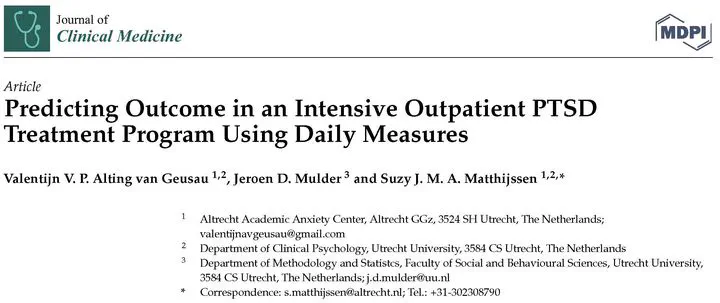Predicting outcome in an intensive outpatient PTSD treatment program using daily measures
Sep 15, 2021·,,
Valentijn v. P. Alting Van Geusau
Jeroen D. Mulder
Suzy J. M. A. Matthijssen

Abstract
It is useful to investigate factors that could predict treatment outcomes for PTSD. The current study aims to investigate the relationship between daily measured PTSD symptoms during an intensive six-day treatment program and overall post-treatment outcomes. The treatment program combines eye movement desensitization with reprocessing and prolonged exposure, as well as physical activity and psychoeducation. It was expected that for the entire duration of treatment, as well as the first half of the treatment, a greater decline in daily PTSD symptoms would be a predictor for a greater decline in PTSD symptoms at a four-week follow-up. Data from 109 PTSD-patients (87.2% female, mean age = 36.9, SD = 11.5) were used. PTSD symptoms were measured with the CAPS-5 and the self-reported PTSD checklist for DSM-5 (PCL-5). Daily PTSD symptoms were measured with an abbreviated version of the PCL-5 (8-item PCL). Latent growth curve models were used to describe changes in daily PTSD symptoms and predict treatment outcome. Results show that a greater decline in daily PTSD symptoms measured by the 8-item PCL predicts better treatment outcome (CAPS-5 and PCL-5), but that a patient’s PTSD symptoms on the first day of treatment has no predictive effect. A decline in PTSD symptoms only during the first half of treatment was also found to predict treatment outcomes. Future research should be focused on replicating the results of the current study.
Type
Publication
Journal of Clinical Medicine, 10(18)